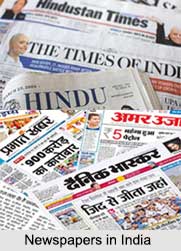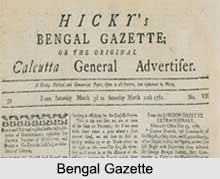 Newspapers in India are said to offer majority of national and international news. Indian print media is at a massive business in the media world. Newspaper can be defined as a printed means of passing on up to date information. The Indian language newspapers eventually took over the English newspapers according to the National Readership Survey of newspapers.
Newspapers in India are said to offer majority of national and international news. Indian print media is at a massive business in the media world. Newspaper can be defined as a printed means of passing on up to date information. The Indian language newspapers eventually took over the English newspapers according to the National Readership Survey of newspapers.
History of Newspapers in India
The history of newspaper in India began in 1780, with the publication of the "Bengal Gazette" from Kolkata. The advent of the first newspaper in India occurred in the capital city of West Bengal, Calcutta (now Kolkata). James Augustus Hickey is considered the "father of Indian press" as he started the first Indian newspaper from Kolkata, the `Bengal Gazette` or `Calcutta General Advertise` in January, 1780. This first printed newspaper was a weekly publication. In 1789, the first newspaper from Bombay (now Mumbai), the `Bombay Herald` appeared, followed by the `Bombay Courier` in the following year. Later, this newspaper merged with the Times of India in 1861. These newspapers carried news of the areas under the British rule.
The first newspaper published in an Indian language was the "Samachar Darpan" in Bengali during the period of Lord Hastings. The first issue of this daily was published from the Serampore Mission Press on May 23, 1818. On July 1, 1822 the first Gujarati newspaper, the "Bombay Samachar", was published from Mumbai, which is still in existence. The first Hindi newspaper, the "Samachar Sudha Varshan" started its circulation in 1854. Since then, the prominent Indian languages in which newspapers had been published over the years are Hindi, Marathi, Tamil, Malayalam, Telugu, Urdu and Bengali languages.
 Some merchants of Kolkata started "Calcutta Chronicle" in 1811 and the editor was James Silk Buckingham who had introduced a new approach to Journalism in India. Then, Raja Ram Mohan Roy started a Bengali newspaper "Sambad Kaumudi" in 1822 and a Persian paper "Mirat-ul-Akhbar" in 1822. The Times of India issued its first edition as "The Bombay Times" and "Journal of Commerce" in 1838. In 1868, "Amrit Bazaar Patrika" was started by two brothers, Shishir Kumar Ghosh and Motilal Ghosh. "The Hindu" was started in the English language in 1878. After independence, news agency services became available on a regular basis with the "Press Trust of India" which was started in 1946.
Some merchants of Kolkata started "Calcutta Chronicle" in 1811 and the editor was James Silk Buckingham who had introduced a new approach to Journalism in India. Then, Raja Ram Mohan Roy started a Bengali newspaper "Sambad Kaumudi" in 1822 and a Persian paper "Mirat-ul-Akhbar" in 1822. The Times of India issued its first edition as "The Bombay Times" and "Journal of Commerce" in 1838. In 1868, "Amrit Bazaar Patrika" was started by two brothers, Shishir Kumar Ghosh and Motilal Ghosh. "The Hindu" was started in the English language in 1878. After independence, news agency services became available on a regular basis with the "Press Trust of India" which was started in 1946.
Press Trust of India
Press Trust of India is the largest news agency in India. Located at Delhi, it is a non-profit two-way among more than 500 Indian newspapers. It gives news reporting and information of the area in both English and Hindi. It employs over 400 journalists and 500 part-time correspondents situated in most of the district headquarters in the country.
List of Newspapers in India
Following is a list of the newspapers in India by readership according to the Indian Readership Survey (IRS) 2014:
•The Times of India
•Dainik Jagran
•Hindustan Dainik
•Dainik Bhaskar
•Malayala Manorama
•Daily Thanthi
•Rajasthan Patrika
•Amar Ujala
•Mathrubhumi
•Lokmat
•Ananda Bazar Patrika
•Eenadu
•Patrika
•Gujarat Samachar
•Hindustan Times
•Sakal
•Nava Bharat
•Sakshi
•Parichay Times
Some of the other popular newspapers in India are Sikkim Express, Jansatta, Punjab Kesari, Arunachal Front, Deccan Chronicle, Deccan Herald, Greater Kashmir, Mid Day, Mumbai Mirror, Seven Sisters Post, The Assam Tribune, The Indian Express, The Telegraph, Samyukta Karnataka, Lokmat, Maharashtra Times, Suryaa, Prabhanjan Sanket and so on.




















